Art & Tech
In Photos: See Inside the American Museum of Natural History’s New Hall of Gems, Dedicated to ‘Nature’s Art’ (and Rihanna’s Necklace)
The hall has been completely renovated to showcase "nature's art."
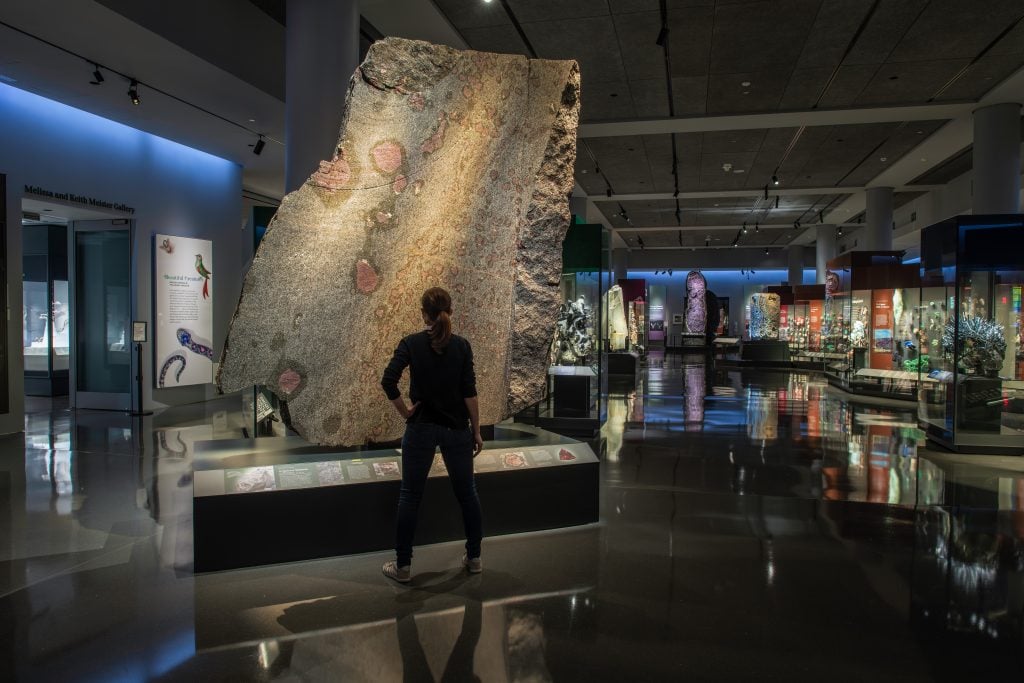
The hall has been completely renovated to showcase "nature's art."

Sarah Cascone

Four years ago, the Halls of Gems and Minerals at New York’s American Museum of Natural History closed for long-overdue renovations. The cavelike space, deliberately designed to evoke the feeling of the mines where many of the specimens on display had been excavated, had been essentially untouched since 1976.
This week, it reopens to the public and features some 5,500 objects, from polished diamonds to rough-hewn sandstone.
“I think it’s fair to say that no space, no gallery is quite as glittering as these new halls,” museum president Ellen Futter said at the press preview.
The 11,000-square-foot halls have traditionally been one of the museum’s most beloved attractions, and the museum is predicting that it will be a major draw for tourists returning to the city.
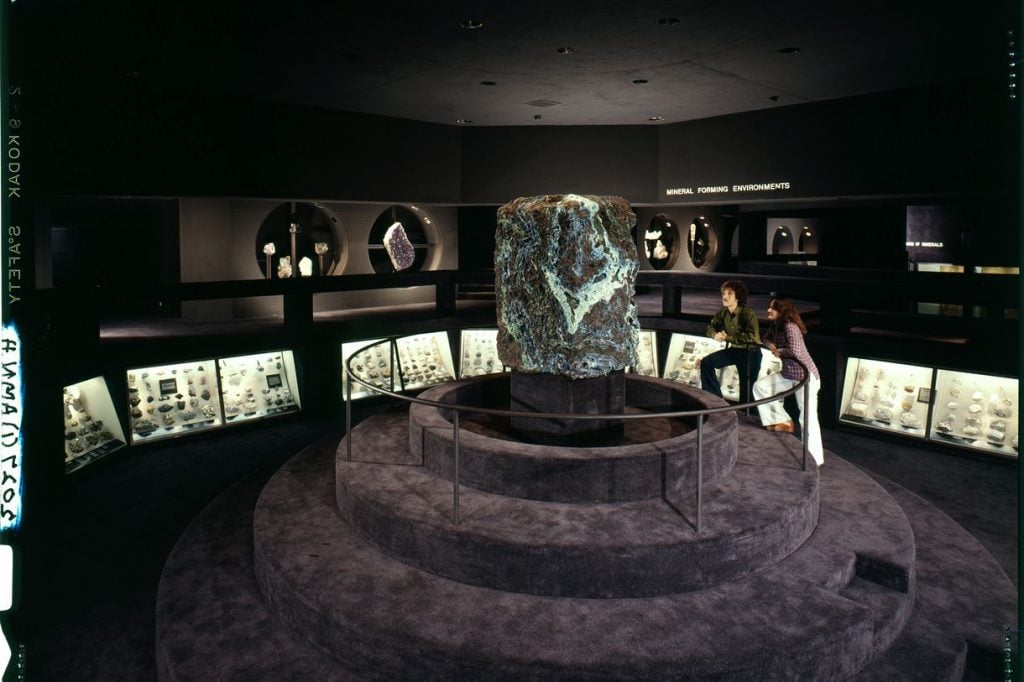
Visitors in Minerals Hall at the American Museum of Natural History (1976) examine the Singing Stone, a 4.5 ton block of vibrant blue azurite and green malachite from Arizona that hums with changes in humidity. The climate control in the new hall prevents this from happening. Photo courtesy of the American Museum of Natural History.
“There is something truly elemental and visceral about our connection to the minerals and materials of the earth on which we live,” Futter said. “Didn’t we all collect rocks as children?… And who among us doesn’t appreciate a spectacular gem?”
Remade by exhibition design firm Ralph Appelbaum Associates courtesy of benefactors and new namesakes Roberto and Allison Mignone, the hall is virtually unrecognizable from the dark gallery with carpeted ramps and floor-level display cases it used to be.
“I called [it] the jungle gym and the nanny-dom,” George Harlow, the museum’s curator of the department of earth and planetary sciences, said at the press preview.

The entrance to the new galleries features a pair of towering amethyst geodes that are among the world’s largest on display. Photo by D. Finnin, ©American Museum of Natural History.
New explanations about the evolution of minerals also reflect the latest scientific research.
Today, the most widely accepted theory is that most of the 5,500 known minerals evolved in tandem with life. (The Earth has 10 times more minerals than anywhere else in the Solar System.)
The hypotheses, introduced in 2008, holds that there was an explosion in mineral diversification during the Great Oxidation Event that began some 3 billion years ago, introducing oxygen into the atmosphere and leading to boldly colorful minerals.
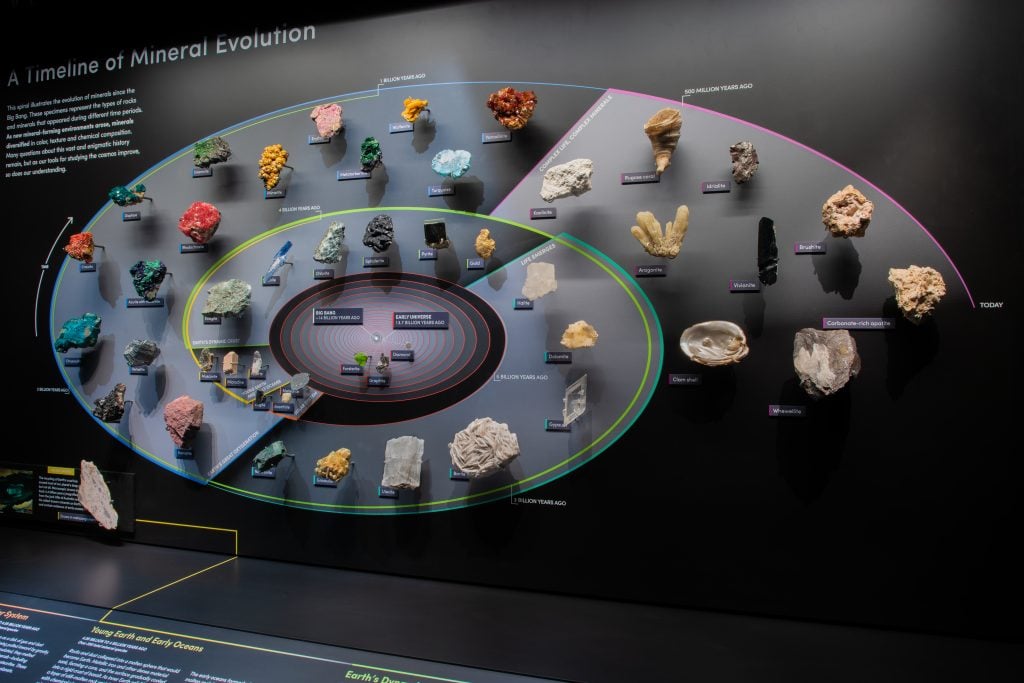
This display illustrates the concept of mineral evolution, a theory which has developed over the past 15 years. Photo by D. Finnin, ©AMNH.
“Without minerals, there really isn’t life,” Harlow said. “Getting people to understand that we have a relationship with minerals makes them more approachable beyond the fact that they can be gobsmackingly beautiful.”
All minerals are naturally occurring solids with crystalline structures and uniform chemical compositions, but they can form in different ways, leading to dramatically different appearances.
Amethyst, citrine, agate, and jasper are all varieties of quartz. Rocks can contain several different minerals. Granite, for instance, is typically a mix of quartz, feldspar, and mica. And then there are the gems—cut and polished minerals that are hard and durable enough to be worn as jewelry.
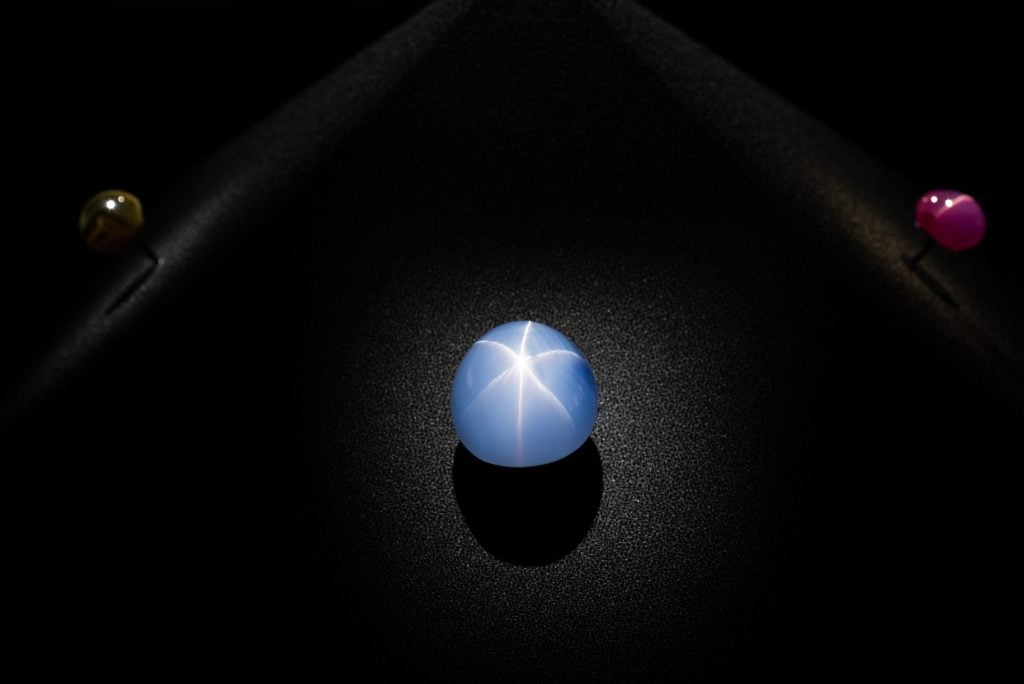
At 563 carats, the Star of India is the world’s largest gem-quality blue star sapphire. Some 2 billion years old, it is one of the most well-known objects in the world. Photo by D. Finnin, ©AMNH.
New additions to the collection include the diamond and platinum Organdie Necklace, worn by Rihanna on the cover of Essence and donated by the New York jewelry dealer Siegelson.
The cream of the crop is perhaps the 563-carat Star of India sapphire, the world’s largest-known gem-quality blue star sapphire. The most famous piece in the museum’s gem collection, it was stolen in a 1964 jewelry heist and later recovered in a Florida bus terminal locker.
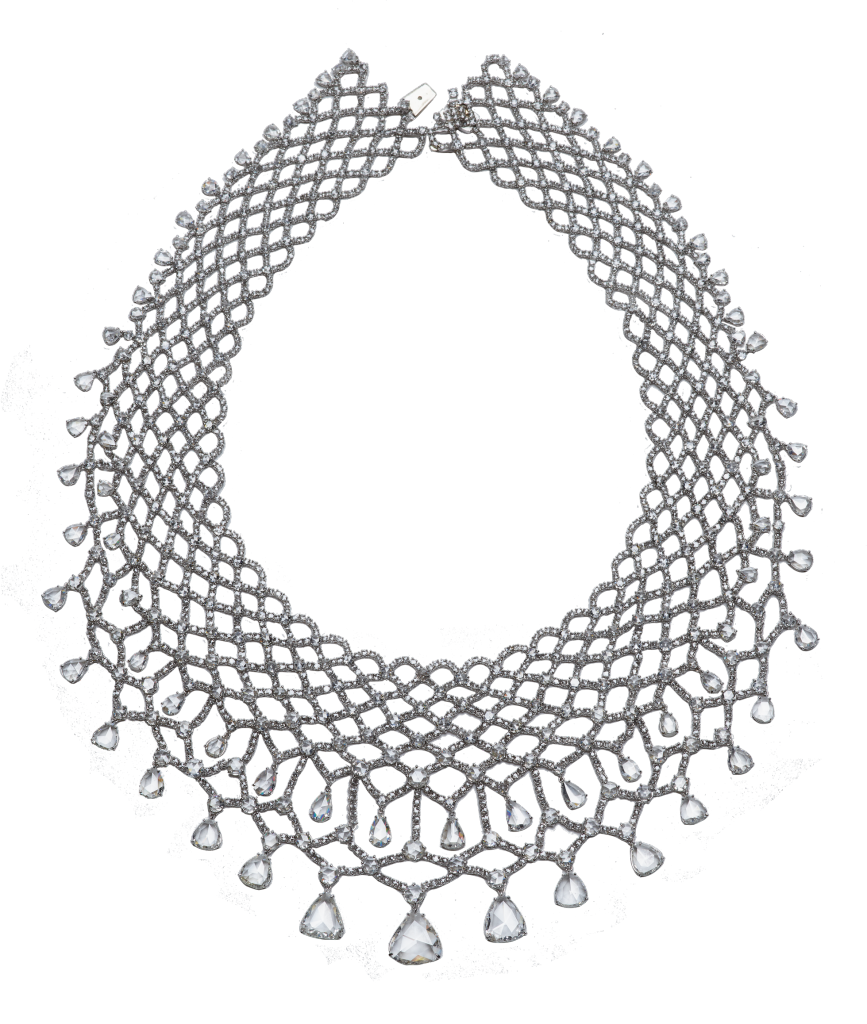
The Organdie Diamond Necklace, a lattice-work girandole bib necklace set with 2,190 round and pear-shape diamonds set in platinum, designed by Michele Ong for Carnet. Rihanna wore this necklace on the cover of Essence magazine in February 2021.
Part of the fun of exploring the hall is discovering all the unfamiliar mineral names: Wulfenite, Almandine, Cubanite, Proustite, and Tantalite, to name just a few.
Then there are the showstoppers, like the Singing Stone, a massive block of bright blue azurite and green malachite from Arizona shown at 1893 World’s Columbian Exposition in Chicago. It emits a high-pitched sound when the humidity changes. (An effect sadly not in evidence in the climate-controlled museum.)

Sterling Hill Fluorescent Rock Panel. The centerpiece of the Minerals & Light room is a wall-sized panel of fluorescent rock that glows in shades of orange and green, sourced from Sterling Hill in New Jersey. Photo by D. Finnin, ©American Museum of Natural History.
Other highlights include the cherry red Tarugo, an Elbaite Tourmaline that at three feet tall is one of the world’s largest intact mineral crystal clusters. And then there’s a 10-ton rock from New Jersey’s Sterling Mine, which fluoresces in red and green when seen under ultraviolet light in a dramatic display.
But perhaps the most memorable are the two monumental amethyst geodes in the “Crystal Garden” display that greet visitors at the hall’s entrance. Striking in their otherworldly beauty, they measure nine and 13 feet tall and weigh in at over 12,000 and 9,000 pounds, respectively.
The 135-million-year-old specimens are from the Bolsa Mine in Artigas, Uruguay, and were created when gas bubbles in magma-formed cavities. As groundwater flowed in, dissolved silica turned into quartz, creating the stunning purple crystals.
“This is a piece of art,” Futter said. “It’s nature’s sculpture.”
See more photos from the halls below.
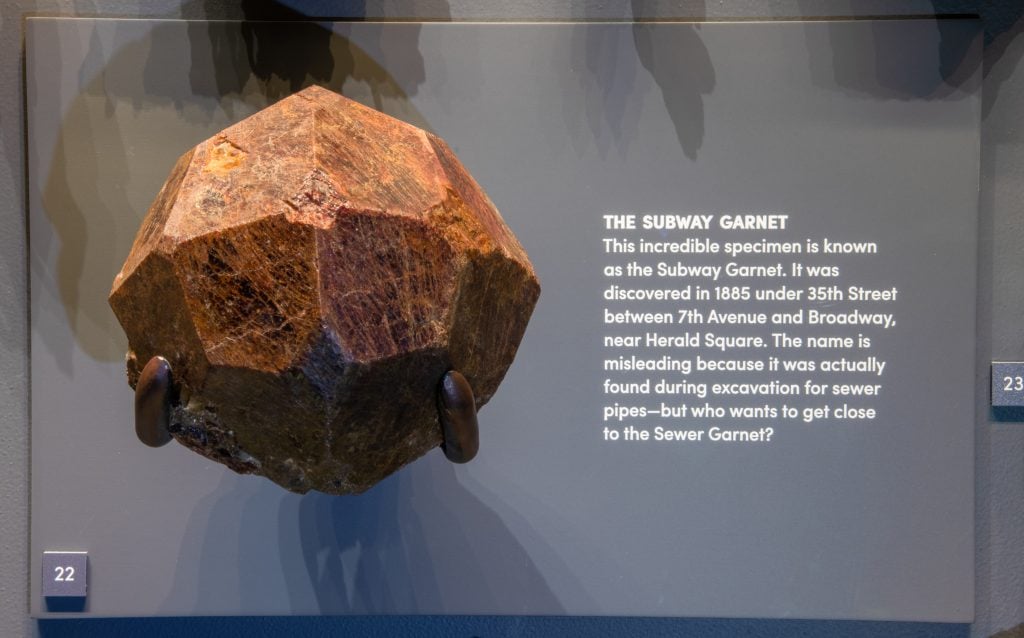
Almandine Subway Garnet. This incredible 10-pound almandine is known as the Subway Garnet. It was discovered in 1885 under 35th Street between 7th Avenue and Broadway, near Herald Square. The name is misleading because it was actually found during excavation for sewer pipes. Photo by D. Finnin, ©AMNH.
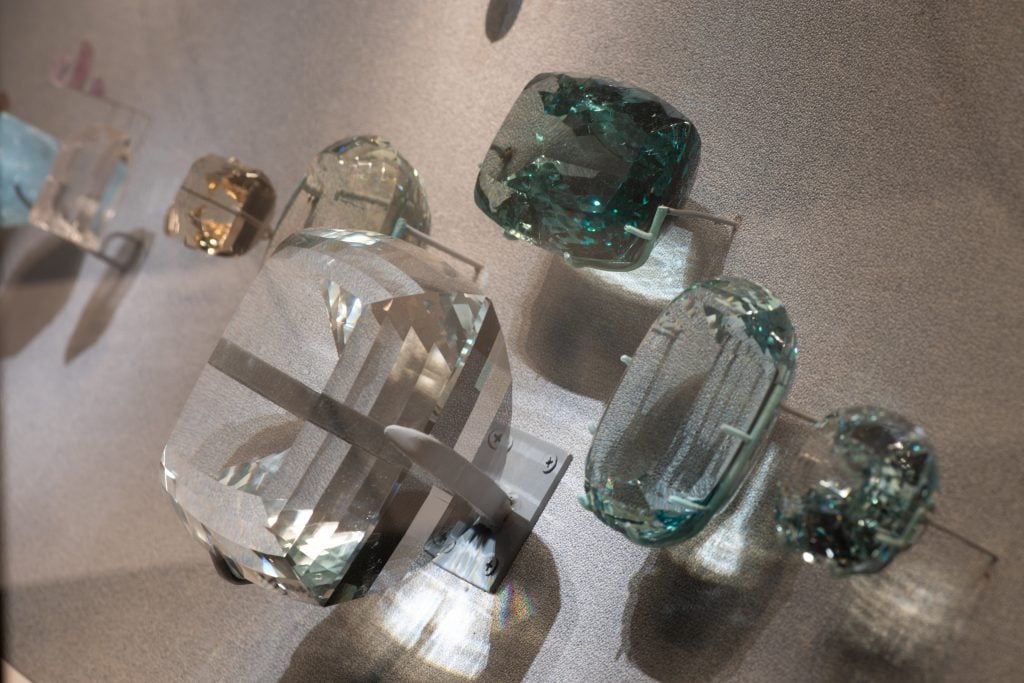
This grouping of topaz gems includes the Brazilian Princess, a 221-facet, 9.5-pound pale blue topaz that once was the largest cut gem in the world. Photo by D. Finnin, ©American Museum of Natural History.
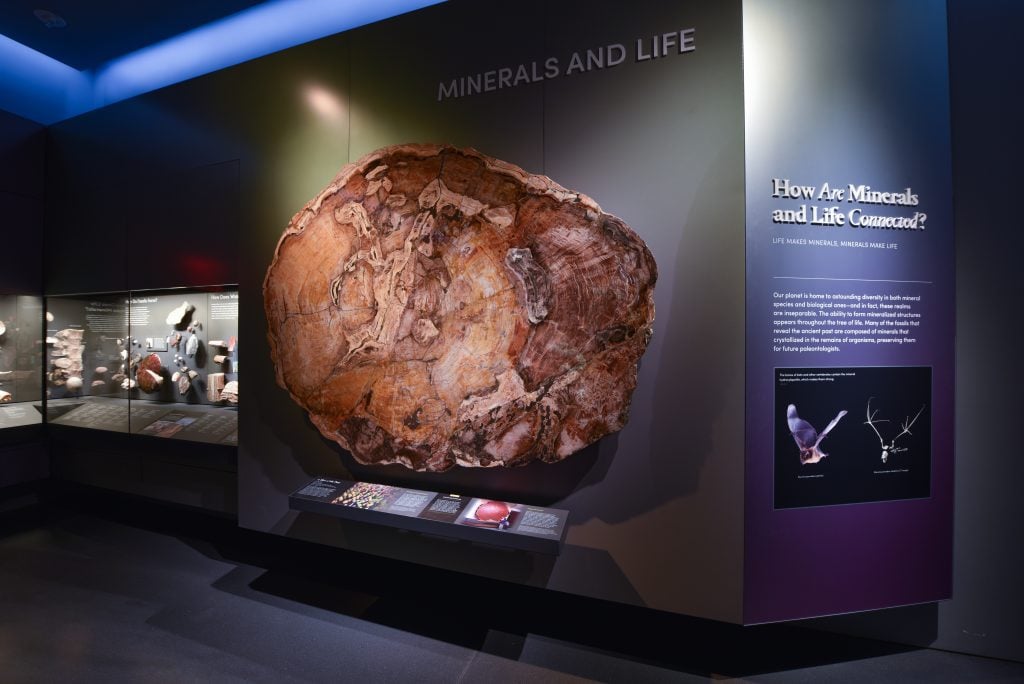
A slice of petrified dawn redwood from central Oregon. The metasequoia specimen is part of the same sub-family as the giant redwood in the museum’s Hall of North American Forests. Photo by D. Finnin, ©American Museum of Natural History.
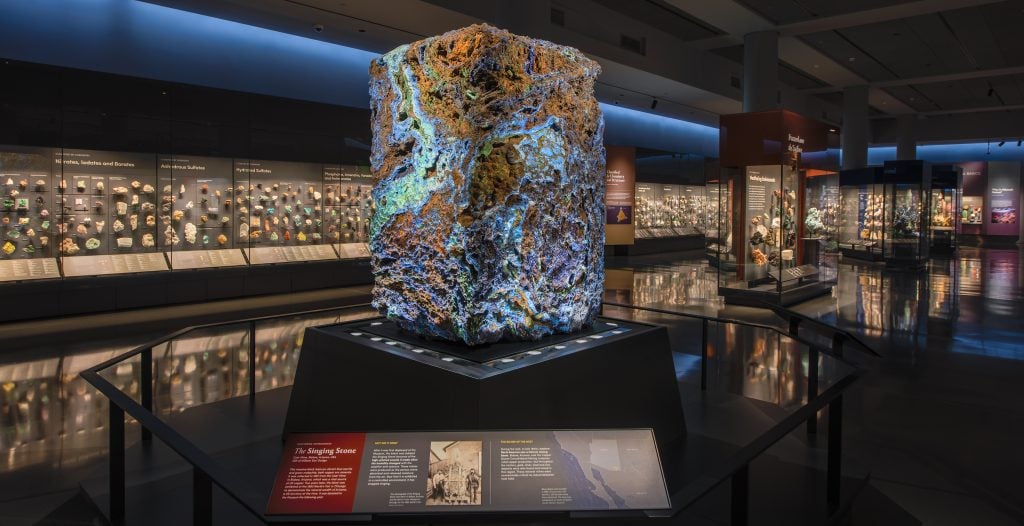
Known as the Singing Stone, this massive 4.5 ton block of vibrant blue azurite and green malachite from Arizona was first exhibited at the 1893 World’s Columbian Exposition in Chicago. After it was first displayed at the museum, this block was dubbed the Singing Stone because of the high-pitched sounds it made when the humidity changed with the weather and seasons. Now that it is exhibited in a controlled environment, it has stopped singing. Photo by D. Finnin, ©American Museum of Natural History.
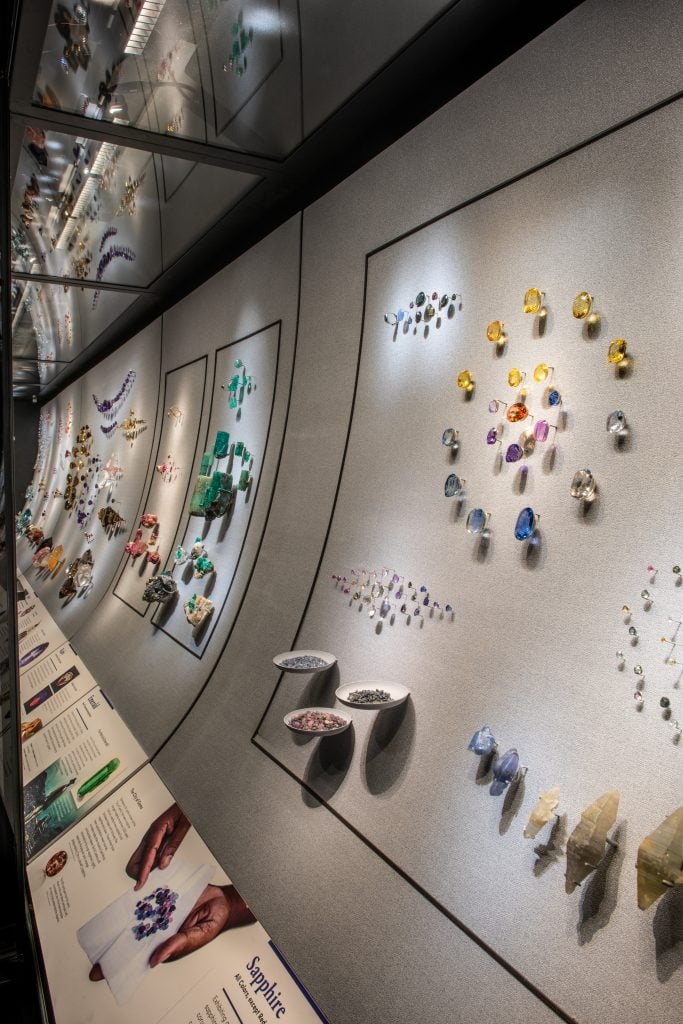
The Gems Hall displays nearly 2,500 objects from the museum’s collection. These include precious stones, carvings, and stunning jewelry from around the world that were fashioned from naturally beautiful minerals. Photo by D. Finnin, ©American Museum of Natural History.
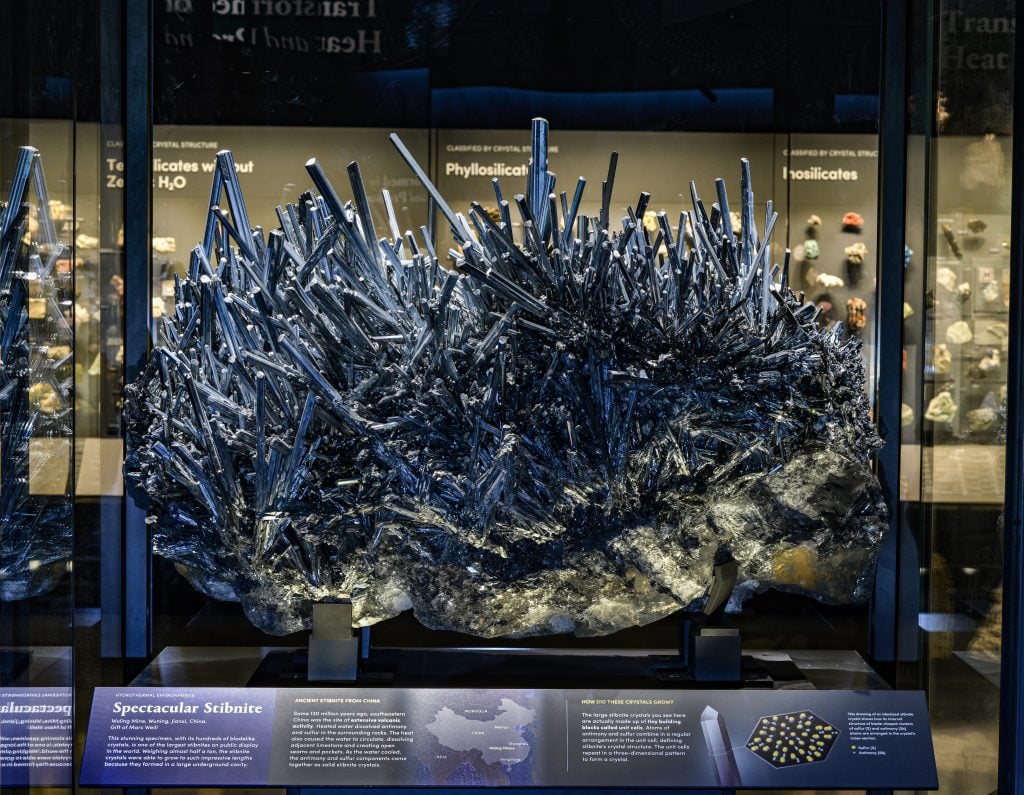
Weighing almost half a ton and showcasing hundreds of swordlike crystals, this is one of the largest stibnite specimens on public display, and is sourced from southeastern China. Photo by D. Finnin, ©American Museum of Natural History.

This 3-foot-tall cranberry-red elbaite tourmaline known as the Tarugo is one of the most fantastic mineral crystal clusters ever found. It was discovered in 1978 in Minas Gerais, Brazil. Photo by D. Finnin, ©American Museum of Natural History.
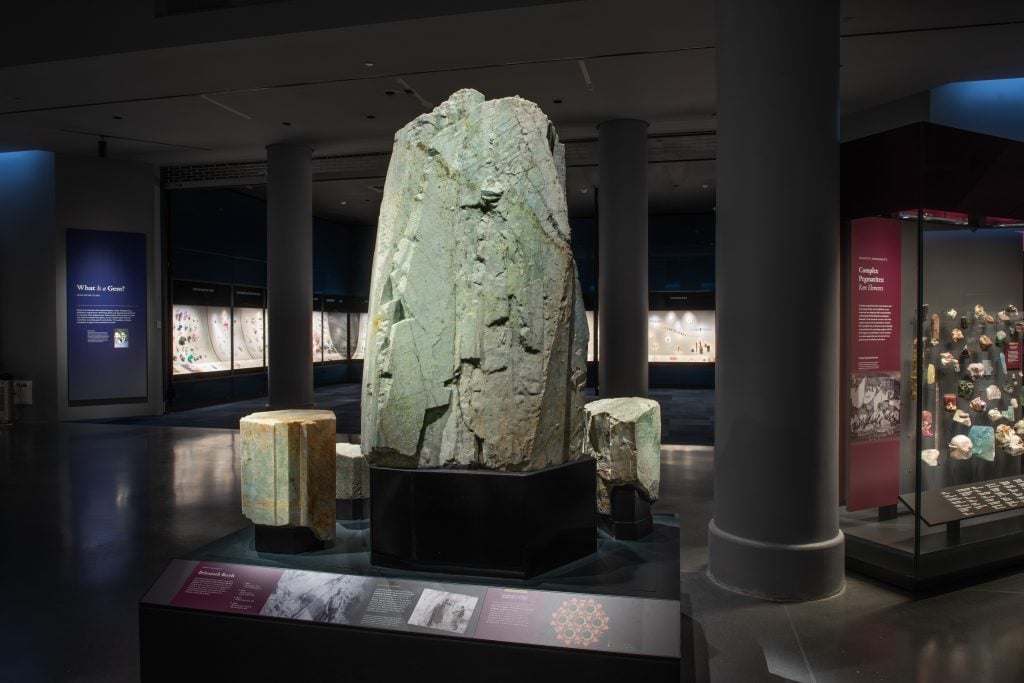
Ranging from blue-green aquamarines, sunny yellow heliodors, and pink morganites to familiar green emeralds, beryls include some of the most popular gemstones. Photo by D. Finnin, ©American Museum of Natural History.
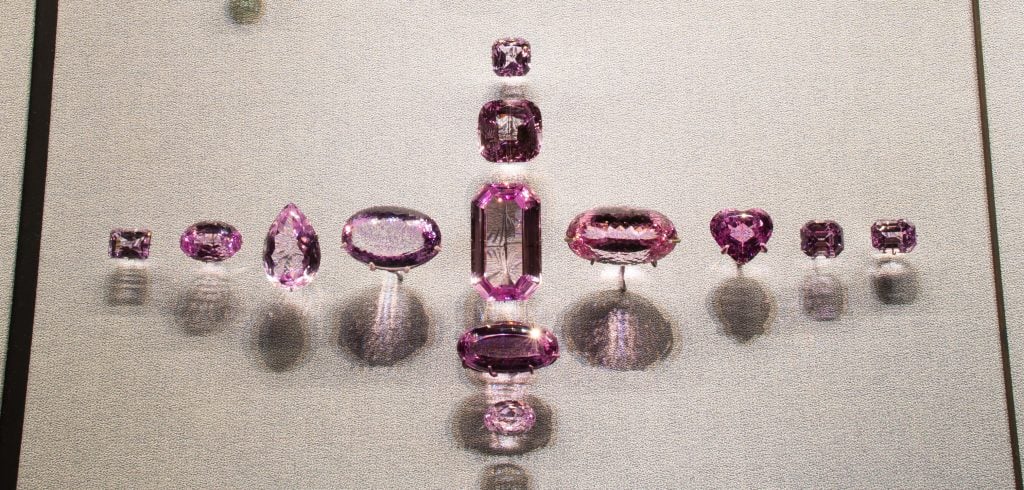
In 1902, transparent lilac-pink crystals arrived at the Tiffany & Company office of George Kunz, who helped establish the gem and mineral collections at the Museum. The sender believed they were tourmaline. Kunz, however, identified the crystals as a new variety of spodumene—the first that wasn’t yellow or green—and it was named kunzite in his honor. Photo by D. Finnin, ©American Museum of Natural History.
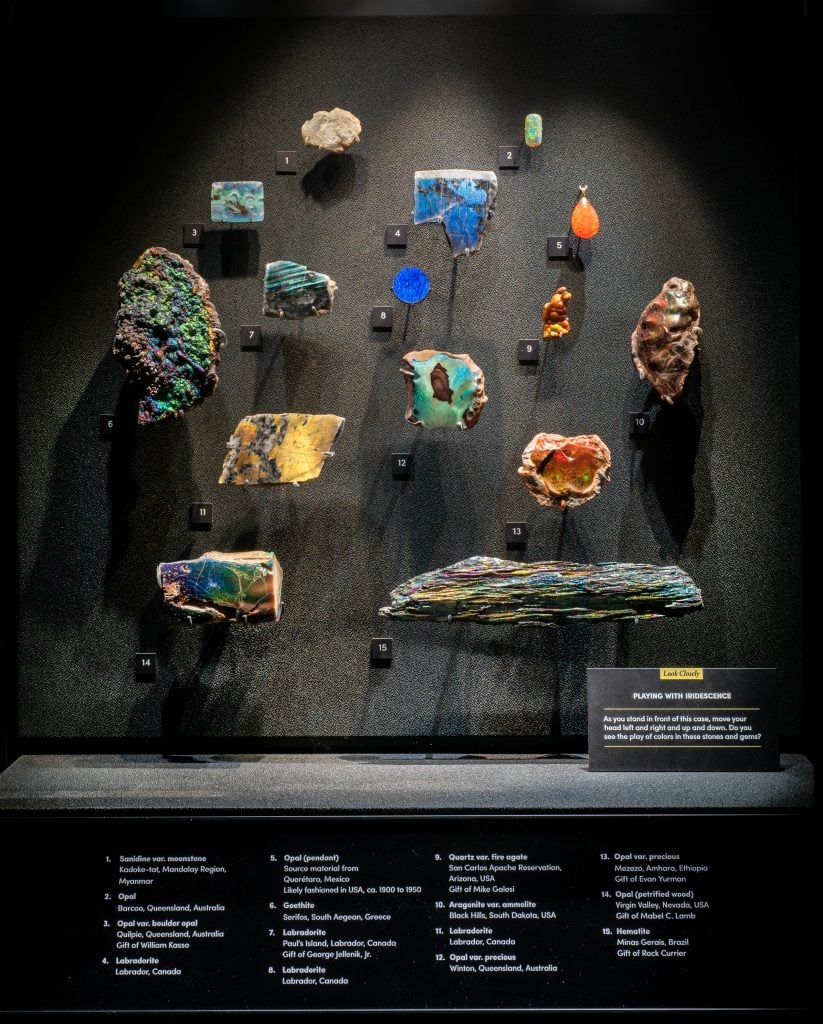
This case highlighting iridescent specimens is part of the Minerals & Light room, which explores the optical properties of minerals and their interaction with light. Photo by Photo by D. Finnin, ©American Museum of Natural History.
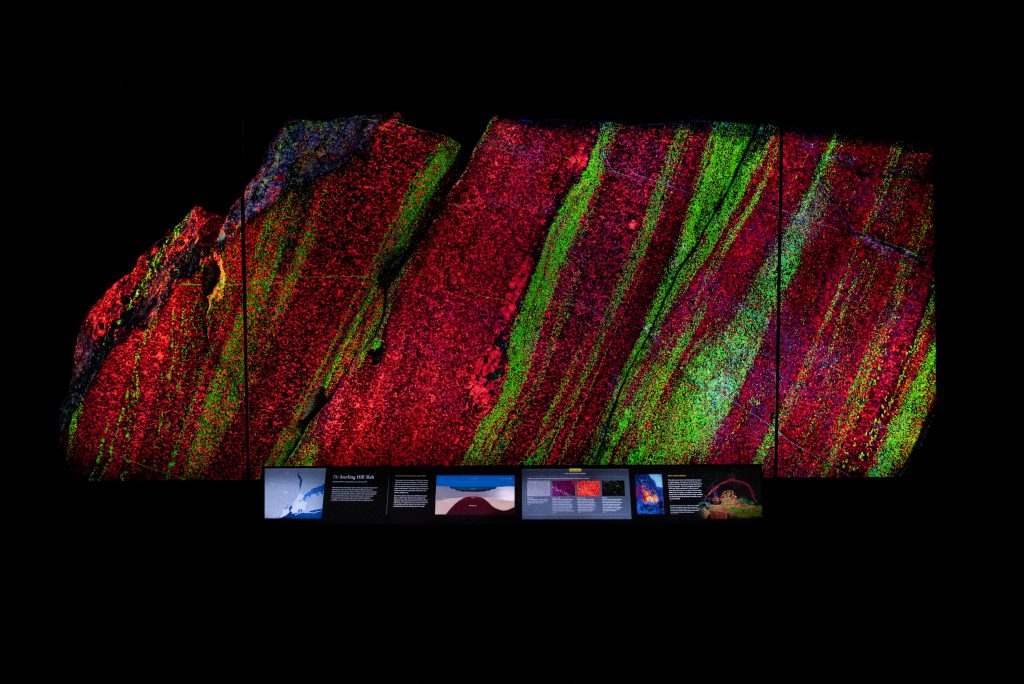
Sterling Hill Fluorescent Rock Panel. The centerpiece of the Minerals & Light room is a wall-sized panel of fluorescent rock that glows in shades of orange and green, sourced from Sterling Hill in New Jersey. Photo by D. Finnin, ©American Museum of Natural History.
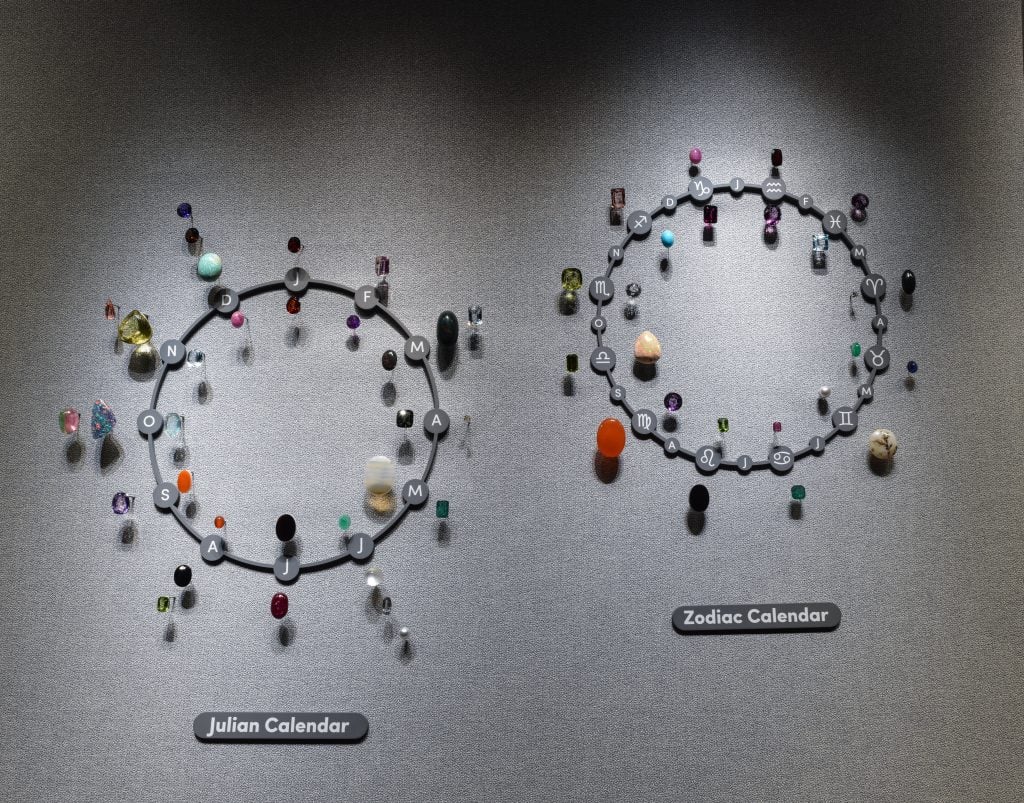
Birthstones are associated with the 12 months of the year and the 12 symbols of the Zodiac, but the specific gems for each month or sign have varied over the centuries and across cultures. The list of birthstones common in the U.S. today dates back to the 1900s, when gemological organizations in the United States and Europe arrived at several standardized lists. The gems in the case represent four different cultural traditions. Photo by D. Finnin, ©American Museum of Natural History.

The 632-carat Patricia Emerald is a dihexagonal, or 12-sided, crystal and is considered one of the great emeralds in the world. Found in Colombia in 1920, it was named after the mine owner’s daughter. This specimen is one of the very few large emeralds that have been preserved uncut. Photo by D. Finnin, ©American Museum of Natural History.
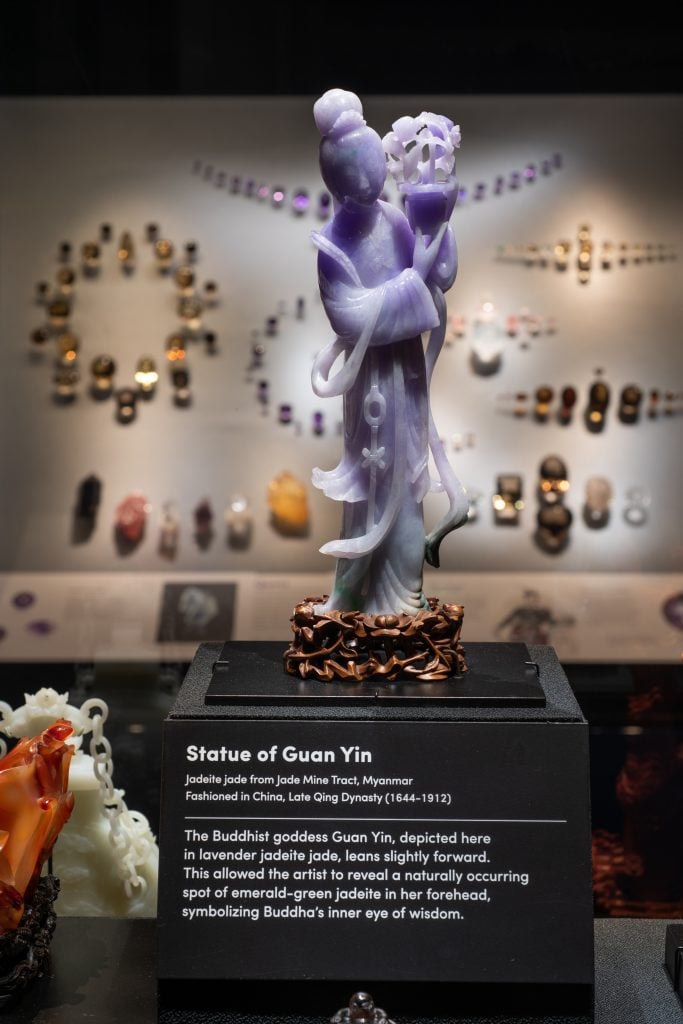
A carving of the Buddhist deity Guan Yin in lavender jadeite jade, fashioned in China during the late Qing Dynasty. Photo by D. Finnin, ©American Museum of Natural History.
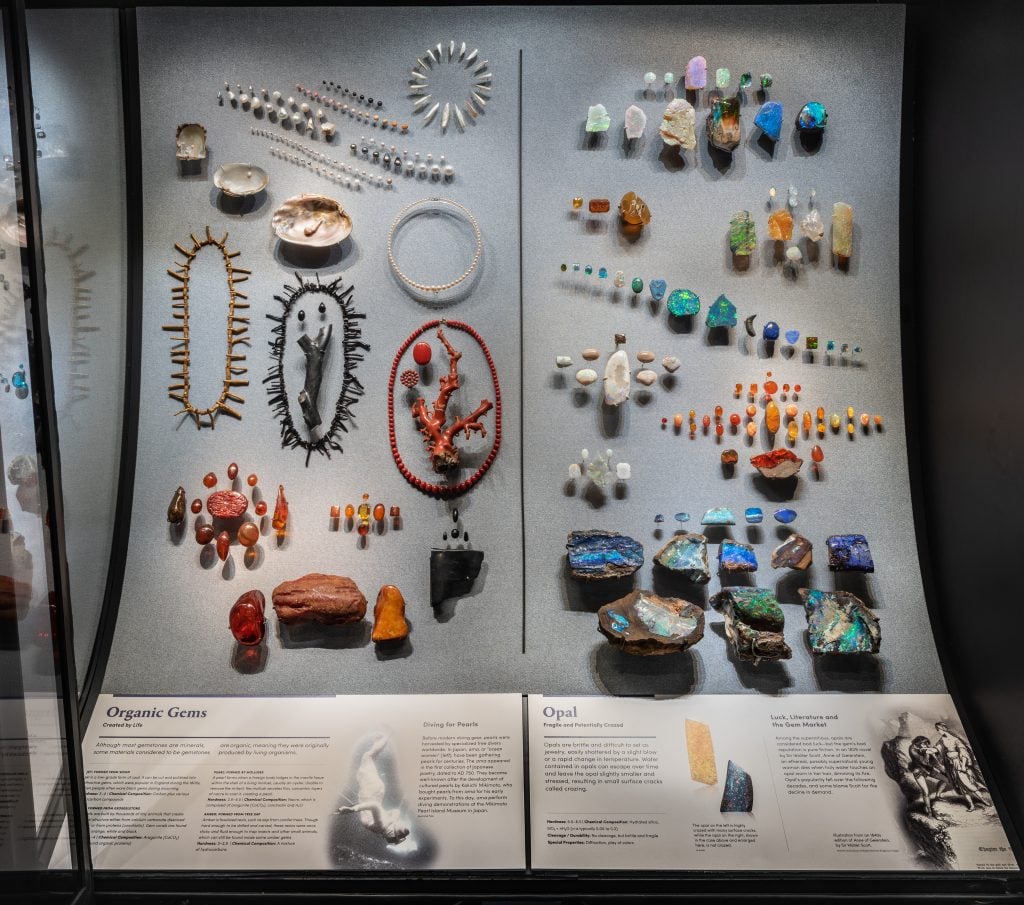
This case in the Gem Hall features organic gems—those originally produced by living organisms, like jet (formed from wood), coral (formed from exoskeletons), pearl (formed by mollusks) and amber (formed from tree sap)—and opals, which are brittle and often difficult to set as jewelry. Photo by D. Finnin, ©American Museum of Natural History.
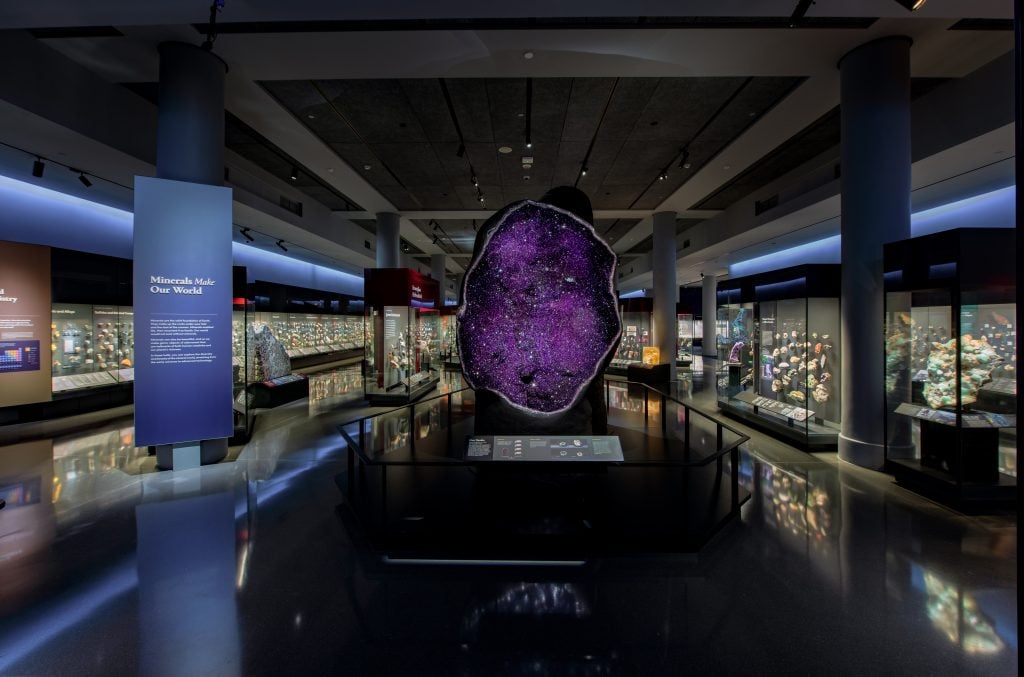
The entrance to the Halls of Gems and Minerals at the American Museum of Natural History. Photo by D. Finnin, ©American Museum of Natural History.

This case displays various specimens of jade, a tough and dense material that’s most famously green, but can also be white, black, or purple. Photo by D. Finnin, ©American Museum of Natural History.
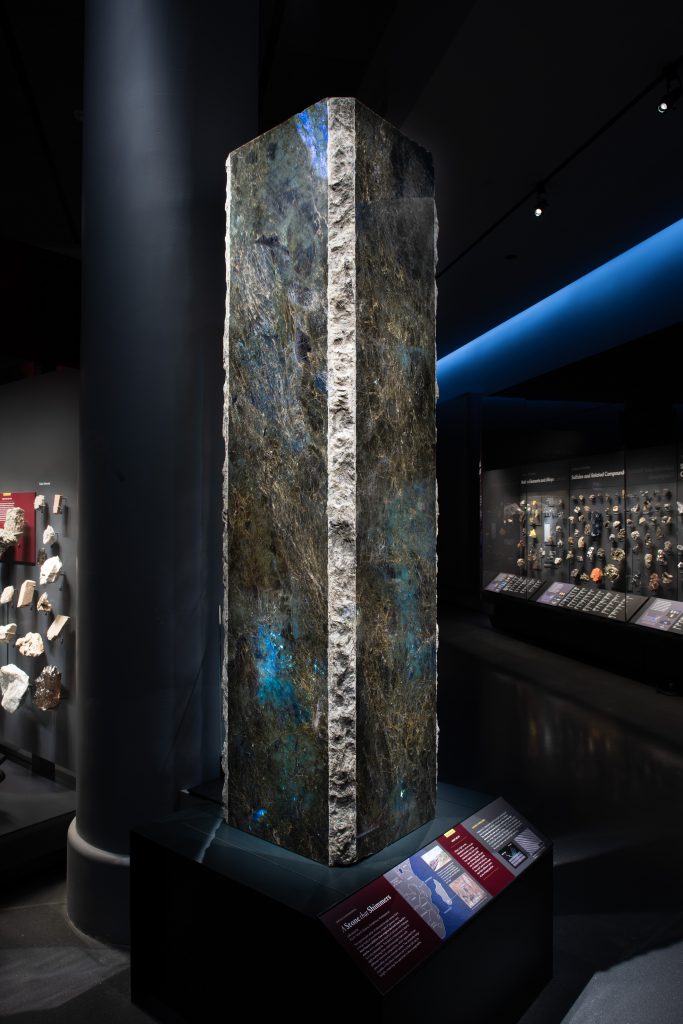
An iridescent block of labradorite from Madagascar, made up of large crystals of feldspar that display vibrant colors with changes in viewing angle. Photo by D. Finnin, ©American Museum of Natural History.

The Halls of Gems and Minerals at the American Museum of Natural History. Photo by D. Finnin, ©American Museum of Natural History.
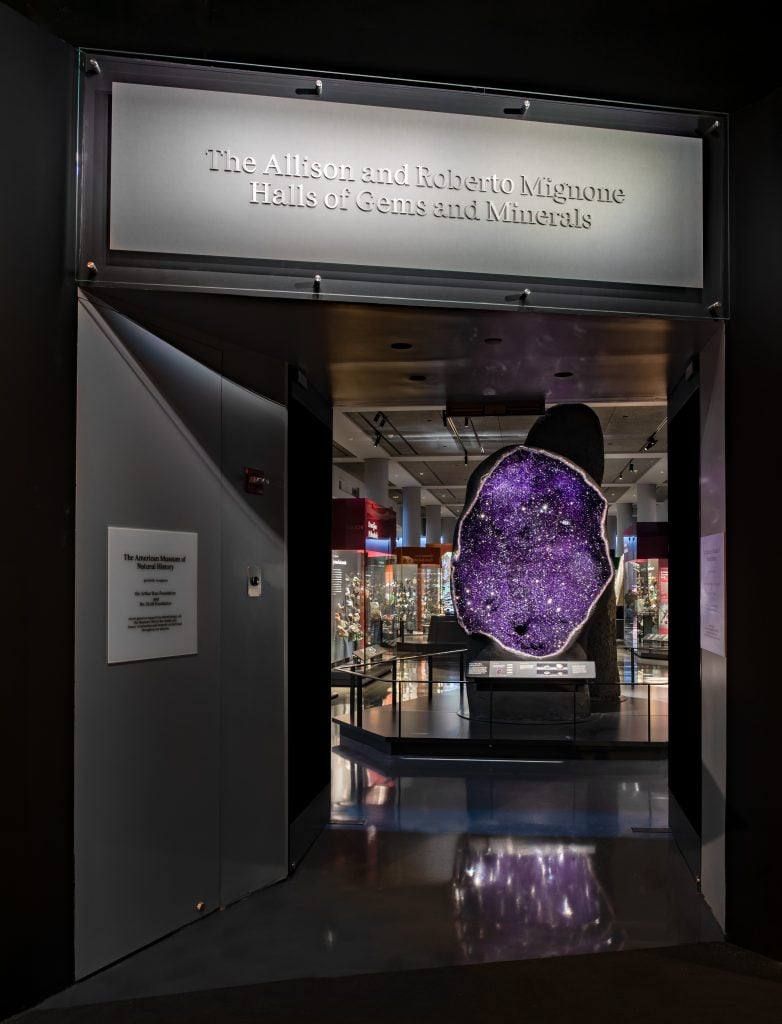
The entrance to the Halls of Gems and Minerals at the American Museum of Natural History. Photo by D. Finnin, ©American Museum of Natural History.
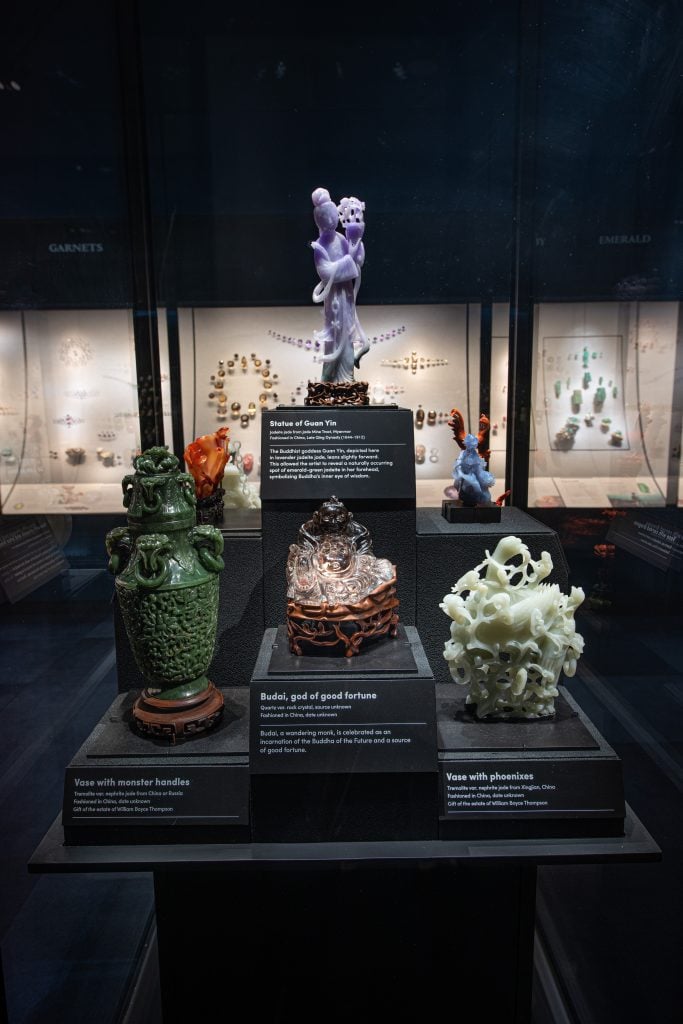
In addition to the Guan Yin statue (top), other carvings in the Gem Hall include, from left, a vase with monster handles made out of nephrite jade, Budai—a wandering monk celebrated as god of good fortune—made from quartz, and a vase with phoenixes made from nephrite jade. Photo by D. Finnin, ©American Museum of Natural History.
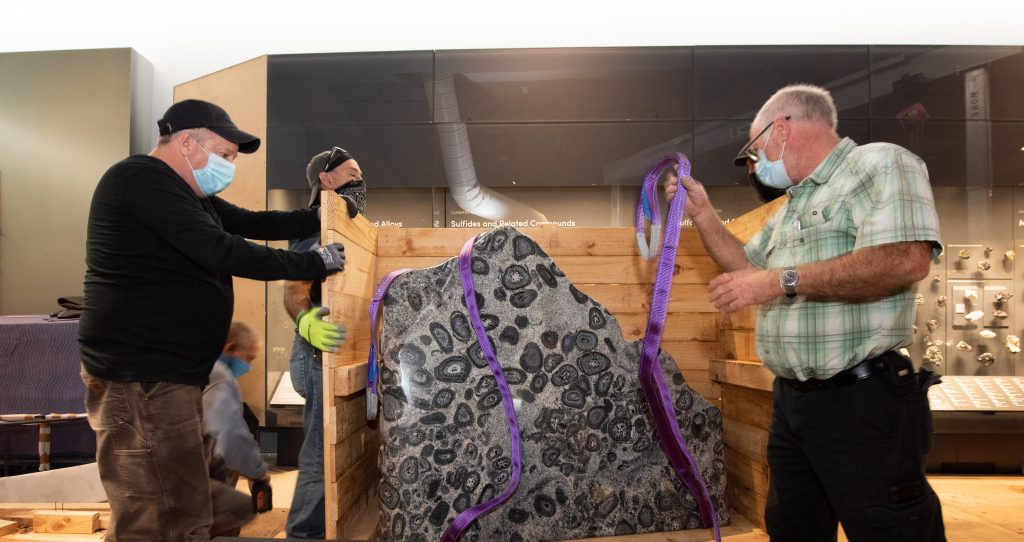
The installation of an orbicular granite from the Yilgarn Craton in Western Australia in the all-new Halls of Gems and Minerals at the American Museum of Natural History. Photo by D. Finnin, ©American Museum of Natural History.
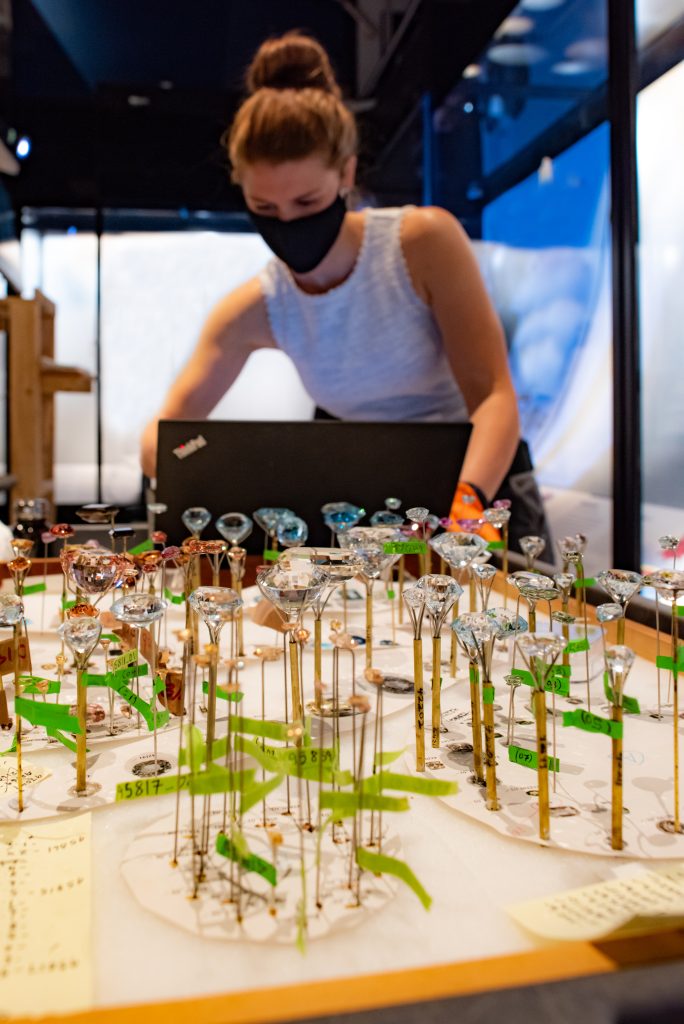
Exhibition staff members install specimens in the all-new Halls of Gems and Minerals at the American Museum of Natural History. Photo by D. Finnin, ©American Museum of Natural History.
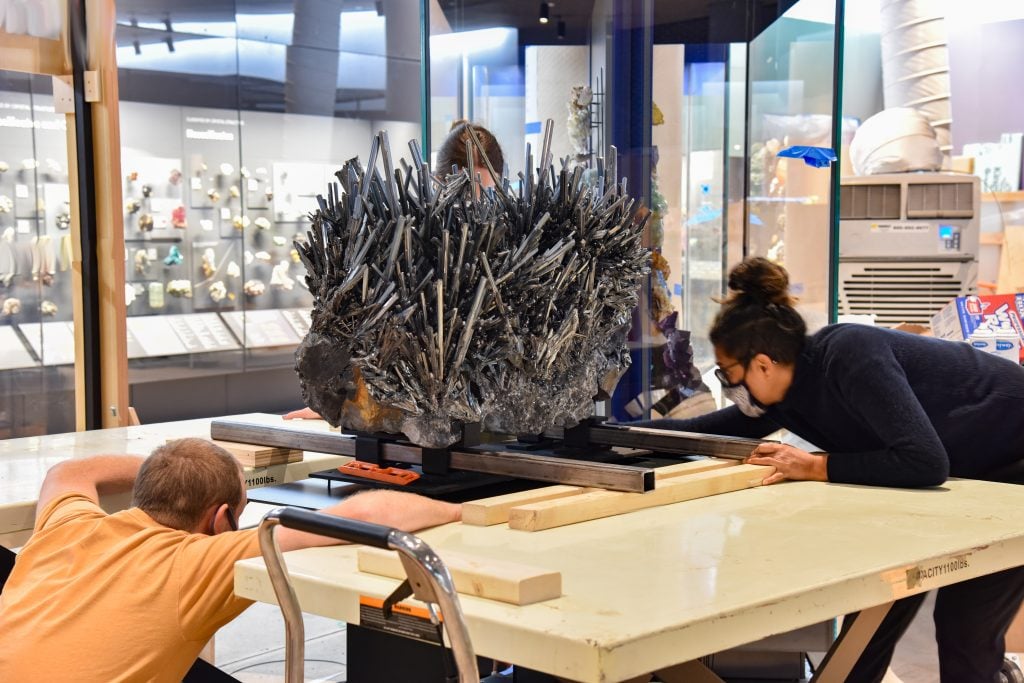
Exhibition staff members install a nearly-half-ton stibnite specimen in the all-new Halls of Gems and Minerals at the American Museum of Natural History. Photo by D. Finnin, ©American Museum of Natural History.
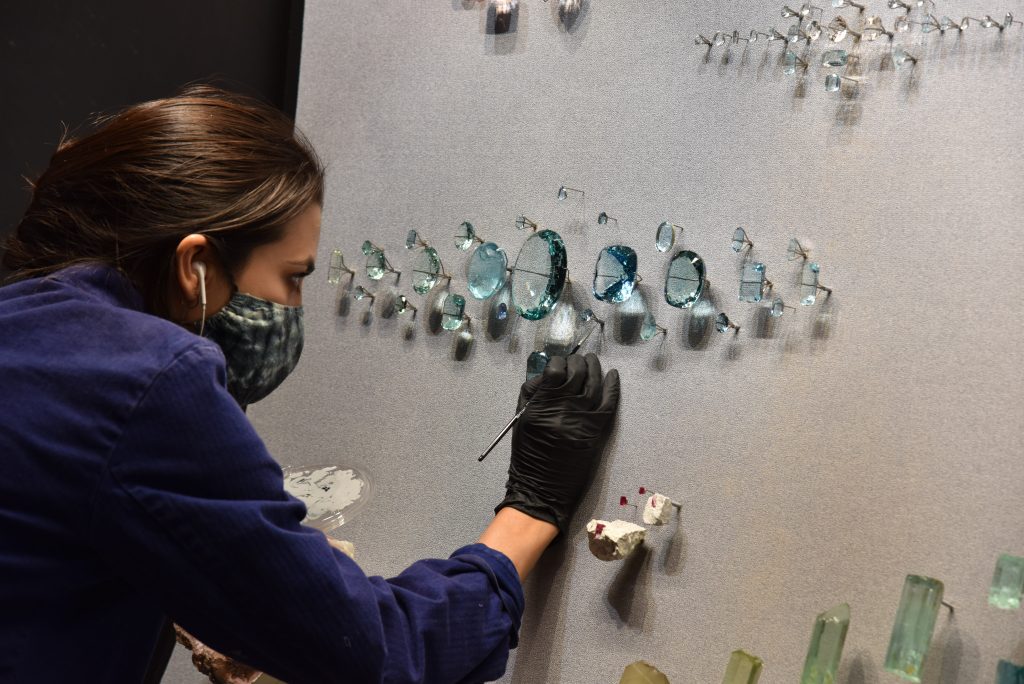
Exhibition staff members install specimens in the all-new Halls of Gems and Minerals at the American Museum of Natural History. Photo by D. Finnin, ©American Museum of Natural History.
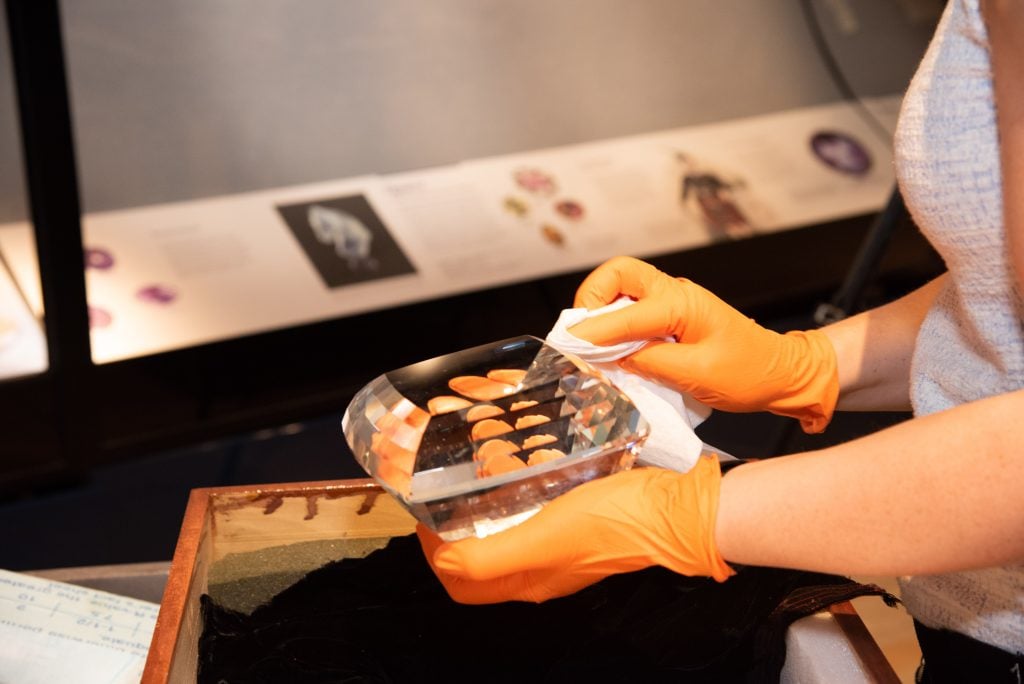
Exhibition staff members install specimens in the all-new Halls of Gems and Minerals at the American Museum of Natural History. Photo by D. Finnin, ©American Museum of Natural History.
The Halls of Gems and Minerals opens at the American Museum of Natural History, 200 Central Park West, New York, on June 12, 2021.